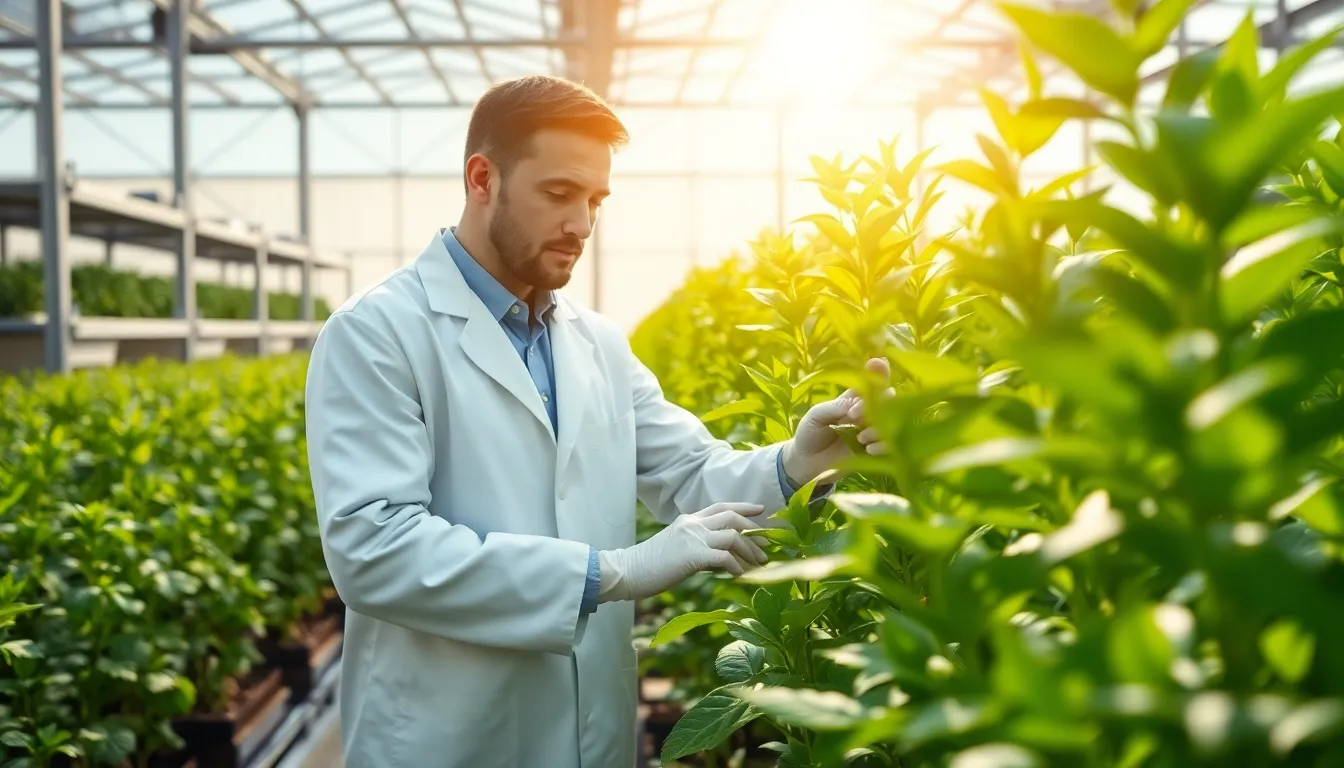Table of Contents
ToggleIn a world where climate change feels like that awkward guest at every party, biotech emerges as the superhero we didn’t know we needed. Armed with cutting-edge science and a touch of creativity, biotechnology is stepping up to tackle some of our planet’s most pressing environmental challenges. From biofuels that promise to kick fossil fuels to the curb, to genetically modified organisms designed to thrive in harsh conditions, the potential is as vast as the ocean.
Overview of Biotech Environmental Impact
Biotechnology significantly influences environmental sustainability. By developing biofuels, it reduces the dependency on fossil fuels, thereby lowering greenhouse gas emissions. Similarly, genetically modified organisms (GMOs) enhance agricultural resilience, enabling crops to thrive in challenging conditions.
Governments and industries utilize biotechnological innovations to tackle pressing ecological issues. For instance, bioremediation employs microorganisms to clean up contaminated environments, proving effective in restoring ecosystems. Additionally, synthetic biology creates tools for environmental monitoring, which helps in detecting pollutants efficiently.
The integration of biotechnology contributes to more efficient resource management. This sector enhances the capacity to produce food sustainably while minimizing waste. It also promotes the development of biodegradable materials, reducing plastic pollution significantly.
Numerous studies highlight the benefits of biotech in environmental applications. According to the U.S. Department of Energy, biofuels can decrease carbon emissions by up to 86% compared to fossil fuels. Furthermore, genetically engineered crops can decrease pesticide usage by 37%, showcasing their role in reducing chemical impacts on the environment.
In essence, biotechnology represents a transformative force addressing environmental concerns. Through innovative practices, it emphasizes sustainable solutions that align with global needs, creating a path toward a more sustainable future.
Positive Aspects of Biotech

Biotechnology presents numerous advantages that positively impact the environment. It addresses pressing environmental challenges through innovative solutions and efficient practices.
Enhanced Crop Resilience
Enhanced crop resilience plays a vital role in food security and environmental sustainability. Biotech advancements enable the development of crops that tolerate extreme weather, such as drought and floods. Genetically engineered varieties often outperform traditional crops in adverse conditions, increasing yields and reducing agricultural losses. Improved resilience lessens the need for chemical inputs. This transformation allows farmers to maintain productivity despite climate variability, ultimately supporting diverse ecosystems and promoting farming sustainability.
Reduction in Chemical Use
Reduction in chemical use emerges as another significant benefit of biotechnology. Genetically modified organisms (GMOs) often require fewer pesticides, allowing for a decrease in harmful chemical applications. Research indicates that genetically engineered crops can reduce pesticide usage by 37%. Less chemical reliance fosters healthier soil and water ecosystems while protecting beneficial insects. Through biopesticides and bioherbicides, biotech enhances pest management strategies, decreasing agricultural environmental footprints. This shift promotes safer, more sustainable agricultural practices that protect natural resources.
Negative Aspects of Biotech
Biotechnology poses some environmental challenges that warrant attention. While it offers significant benefits, the negative aspects can impact ecosystems and soil health.
Potential Biodiversity Loss
Genetically modified organisms (GMOs) may contribute to biodiversity loss by outcompeting native species. Additionally, the introduction of these organisms can disrupt local ecosystems. Some studies indicate that monoculture practices associated with biotech crops lead to reduced genetic diversity among plant species. Loss of diverse genetic resources hinders adaptation to changing environmental conditions, impacting agricultural resilience. Conservationists express concerns that biodiversity loss from biotech practices may have lasting effects on ecosystems. Sustainable approaches need to address these challenges, ensuring balance in agricultural systems.
Soil Health Concerns
Soil health presents a critical concern with biotechnological practices. Over-reliance on specific genetically engineered crops can deplete soil nutrients. Soil structure may also deteriorate due to extensive monoculture farming methods. Studies show that diverse crop rotation improves soil microbial health, maintaining nutrient levels. Reduced chemical use associated with biotech crops can initially benefit soil health, yet long-term impacts remain uncertain. Continuous application of GMO crops may disrupt soil ecosystems, potentially leading to decreased fertility. Addressing soil health issues requires integrating diverse agricultural practices that prioritize sustainability.
Regulatory Framework for Biotech
The regulatory framework for biotechnology influences environmental impact significantly, addressing safety, sustainability, and innovation.
Global Policies
International agreements and treaties lay the foundation for biotechnology regulations. The Cartagena Protocol on Biosafety governs the trade of genetically modified organisms, helping countries establish safety assessments. Organizations like the World Health Organization and the Food and Agriculture Organization promote harmonized standards, enhancing safety and environmental protection. Nations are encouraged to collaborate on research, ensuring biotech developments consider ecological impacts. Recent initiatives aim to streamline regulations, balancing innovation with environmental safety. Increased coordination among countries strengthens global efforts to address climate challenges through biotechnological advancements.
Local Regulations
Local regulations vary widely, reflecting regional priorities and environmental conditions. The U.S. Environmental Protection Agency, for example, oversees biotech products for environmental safety. States can implement additional measures tailored to their ecosystems, addressing specific concerns like biodiversity and soil health. These regulations often assess GMOs for potential impacts before they enter the market. Assessments incorporate factors like local pest resistance and crop suitability, ensuring agricultural practices align with local sustainability goals. Engagement with local communities, including farmers and conservation groups, enhances transparency and fosters acceptance of biotechnological applications.
Future Outlook on Biotech Environmental Impact
Anticipating future developments in biotechnology reveals promising innovations to further environmental sustainability. Bioremediation techniques are set to become more sophisticated, allowing for more efficient cleanup of contaminated sites. Innovations in synthetic biology may enhance the monitoring of ecosystems, providing real-time data on environmental health.
Increased adoption of biofuels stands central in reducing carbon emissions, potentially lowering them by up to 86% compared to fossil fuels. Advances in genetic engineering are likely to yield crops with even greater resilience, which supports food security under climate stress. Crop varieties engineered for extreme weather conditions improve agricultural stability and promote diverse ecosystems.
Concerns surrounding biodiversity preservation are evident, making it critical to prioritize ethical considerations. Strategies focused on integrating diverse agricultural practices can mitigate risks associated with monoculture and soil degradation. As genetic modifications foster efficiency, researchers must also evaluate long-term soil health impacts.
Regulatory frameworks will likely adapt alongside advancements in biotechnology. International agreements, such as the Cartagena Protocol on Biosafety, will continue to guide safe GMO assessments. Local oversight from entities like the U.S. Environmental Protection Agency should expand to ensure rigorous evaluation of biotech products before market entry.
Community engagement remains vital, fostering transparency around biotechnological applications. By involving local populations, acceptance can grow, contributing to both environmental resilience and socioeconomic stability. Future trends indicate that a balanced approach that embraces innovation while addressing potential drawbacks shapes a sustainable path forward in biotechnology’s environmental impact.
Biotechnology holds immense promise for tackling environmental challenges while promoting sustainability. Its innovations have the potential to enhance agricultural resilience and reduce reliance on fossil fuels. However, it’s crucial to remain mindful of the possible ecological consequences.
Balancing the benefits of biotech advancements with the need for biodiversity preservation is essential. As regulations evolve and community engagement increases, the integration of diverse agricultural practices will play a vital role in fostering environmental health.
The future of biotechnology in addressing environmental issues hinges on a thoughtful approach that embraces innovation while safeguarding ecosystems. This balanced perspective will be key to ensuring a sustainable future for both the planet and its inhabitants.



